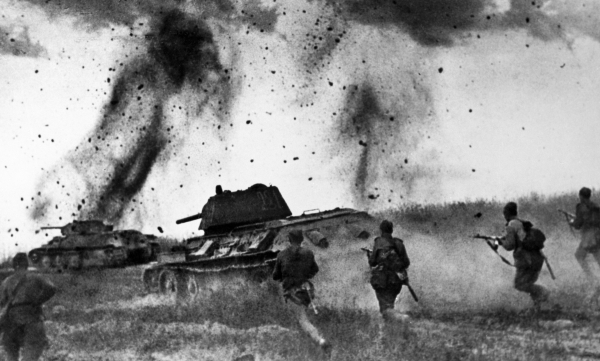
THE BATTLE OF THE TANKS
Kursk, 1943
By Lloyd Clark. 496 pp.
Atlantic Monthly, 2011. $30.
Kursk was one of World War II’s greatest land battles and one of history’s greatest armor engagements, a slugging match that decisively tipped the Eastern Front’s balance in favor of the resurgent Red Army. Operation Citadel, the Wehrmacht’s attempt to use its usually winning tactic of double envelopment, instead delivered the comprehensive victory the Soviet Union needed to turn the tide.
What went wrong? The Germans fought as bravely and skillfully as ever. Yet thanks partly to delays as they waited for new wonder weapons like the massive Tiger tank, they failed to break through the sophisticated Russian defense system, wear down the Red Army’s offensive power, or regain the operational initiative. Crucially, the Germans also failed to comprehend Soviet strategy, which was planned on a scale they simply could not match—embracing the entire Eastern Front, built around a synergy of mass and sophistication seldom equaled and never surpassed in the history of war.
More specifically, the German tankers sustained losses of men and armor that crippled panzer power. From then on, the Wehrmacht could do no more than check the Red Army locally and temporarily. Meanwhile, the Russians mounted the measured sequence of attacks that brought decisive triumph on the Eastern Front in less than two years.
Until fairly recently, though, Kursk has been relatively neglected in favor of more familiar and more glamorous events like Barbarossa and Stalingrad. The Battle of the Tanks goes far to redress that. Author Lloyd Clark belongs to a new generation of British military historians who appeal to both scholars and general readers; he has written successful works on Anzio and the British Rhine campaign of 1944–45. This offering is no less solid: well researched and well written, it integrates frontline narratives and operational analysis. Particularly helpful is Clark’s ability to describe terrain on a huge battlefield where distinguishing features are close to nonexistent.
What sets this work firmly apart, however, is Clark’s recognition that while Kursk was a “battle of the tanks,” it was above all a soldiers’ battle. For all the increasingly elaborate calculations of losses historians have been making, the fact is that neither side ran out of armor. Men, not machines, were the deciding factor. Russia’s T-34 might have been World War II’s best tank, but a hit on its side usually meant a crew roasted alive. The German Tiger might have been invulnerable even to 3-inch shells, but as hits rang on its armor the men inside still wondered when one would find a vulnerable spot. Most decisive, ultimately, were the riflemen who, with no more protection than their uniforms, stalked the steel colossi and each other at close quarters.
Clark demonstrates that in this 10-day death grapple, courage was plentiful but endurance was the critical factor. Like Waterloo, Kursk was hard pounding. Once the Red Army passed that brutal test, it never looked back.




